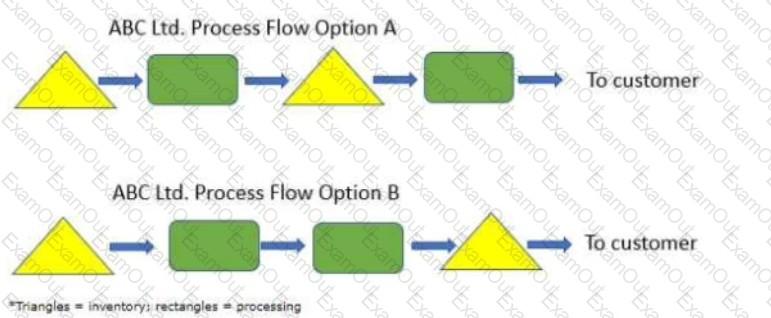A firm has created the following process flow diagrams depicting two possible strategies for the production of a new product line. The triangles represent inventory, and the rectangles represent processing. Each of the two options start with the same raw materials, and both create the product through two stages of processing.

Which of the following statements is correct?
A company develops long range material forecasts, analyzes industry trends, determines commodities for value analysis, and assesses supplier capabilities to assure continual economic supply of goods and services. This company is engaged in
A company determines that demand for an item is steady at 800 units per month, and that the cost of ordering and receiving the item is $300, regardless of how much is ordered. The per item charge is $5, and holding costs are 20% annually. Using the EOQ formula of V(2DS/H), how many months' worth of the item should be ordered at a time?
A manufacturer of gas-powered motors realigns its supply chain to fit a new business segment. In the past, the firm focused on customized designs. Now, it wishes to compete in the electric motor market, which is highly competitive and price-sensitive. Given this situation, which of the following will ensure that the firm has the proper planning in place?
A company saves packaging from incoming shipments and utilizes the cartons to sort parts and pad outgoing pallets. This can BEST be described as
A manufacturing firm's facility operates a level production strategy. The initial demand plan is as follows:
MonthJanFebMarAprMayJunJulAug
Unit Sales12,00026,00026,00021,00020,00020,00015,00020,000
Production20,00020,00020,00020,00020,00020,00020,00020,000
The supply management department learns that one of its retailers is planning a promotional event on August 1st that it expects will require an additional 19,000 units. There are 5,000 units in stock for the beginning of January, and maximum inventory holding is 15,000 units.
How many units per month should production increase in order to meet the requirements of its retailer and minimize overall inventory levels?
Analysis of inventory turnover is generally considered part of what status assessment ratio?
A supply manager oversees three distribution centers. Which of the following will be MOST useful for understanding the capacity of these centers7
Which of the following refers to an agreement between a buyer and supplier in which vendor-owned inventory is stored on the buyer's floor until it is used in production?
A cross-functional team evaluates the feasibility of a new product line for a company. This type of study is BEST described as

